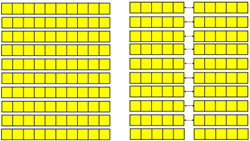The purpose of this activity is to support students deriving new division facts from known facts in a measurement context. For example, if four sets of six can be made from 24, then eight sets of three can also be made from 24.
- Connecting cubes
- Calculators
- Copymaster
- Introduce the following scenario:
Imagine that you work for the cube lolly company. You have a machine that makes lollies, and your job is to put the lollies in packets.
This morning the machine made 30 lollies. (Count out a set of 30 connecting cubes but leave them loose).
The boss wants you to make packets of ten lollies.
How many lollies can you make? (Record 30 ÷ 10 = □)
Note that this context could be adapted to reflect sets of items and totals that are more relevant to your students' cultural backgrounds, interests, and learning in other curriculum areas.
- Let students work in pairs on the problem using whatever strategies they prefer. Some may use place value knowledge by recognising that 3 tens equal 30. Others may make sets of ten, diagrammatically or with materials, until 30 cubes are exhausted.
- Discuss the strategies used and use calculators to confirm the answer.
Record 30 ÷ 10 = 3 and discuss the meaning of ÷ in this context. (Measured in equal sets of…).
- Imagine you get a call from the boss. Sorry, but the lolly shop wants packets of five cubes, instead of ten.
How many packets of five lollies can you make with 30 lollies?
- Let students solve the problem in pairs. As they work, look for:
- Do the students record a division equation?
- Do they use skip counting, addition, or multiplication knowledge to predict the number of packets of five?
- Do they see any connection between the number of packets of ten and the number of packets of five?
- Gather the group to discuss students’ strategies. Verify that six packets of five are made and record the division equation below the fact from dividing by ten.
30 ÷ 10 = 3
30 ÷ 5 = 6
Do you notice any patterns in the two equations?
- Use cubes to show how the two divisions are related.
- Draw special attention to the meaning of each equation in words: “Three packets of ten can be made from 30 lollies,” and “six packets of five can be made from 30 lollies.”
- Write the related multiplication equations, i.e., 3 x 10 = 30 and 6 x 5 = 30.

30 ÷ 10 = 3 30 ÷ 5 = 6
- Pose similar measurement problems with related divisors in the same lolly factory context. Good examples are shown below:
- Illustrate the division relationships using cubes and confirm the result with the calculators.
- Record the division equations and matching multiplication equations.
- Look for patterns in the equations.
| Story | Equations | Cube models |
| 24 lollies made into packets of 8 and packets of 4. | 24 ÷ 8 = 3 3 x 8 = 24 24 ÷ 4 = 6 6 x 4 = 24 |  |
| 30 lollies made into packets of 6 and packets of 3. | 30 ÷ 6 = 5 5 x 6 = 30 30 ÷ 3 = 10 10 x 3 = 30
|  |
| 100 lollies made into packets of 10 and packets of 5. | 100 ÷ 10 = 10 10 x10 = 100 100 ÷ 5 = 20 20 x 5 = 100 | 
|
| 40 lollies made into packets of 4 first then packets of 8. | 40 ÷ 4 = 10 10 x 4 = 40 40 ÷ 8 = 5 5 x 8 = 40 |  |
Allow students to work in groups comprised of students with a range of mathematical understandings, encouraging tuakana-teina and productive learning conversations. Ask students to work out the answers with their own strategies, and explain them using symbols, words, and diagrams, before using connecting cubes (if needed) and a calculator. Early finishers can be challenged to make up their own lollie problems for classmates to solve.
Next steps
- Provide problems, framed in relevant contexts, to which students can apply their deriving strategies. For example, “there are 30 students in our class. We need teams of six for volleyball and teams of three for dodgeball. How many of each team can we make?”
- Connect division by sharing and measurement with multiplication facts to encourage students' development of a knowledge base of known facts. The process might start with images and related questions, such as:
- Which facts does this picture show? a. 5 x 3 = 15, b. 15 ÷ 5 = 3, c. 15 ÷ 3 = 5, d. 3 x 5 = 15.
- Can you help me write some stories about apples to match each fact?
